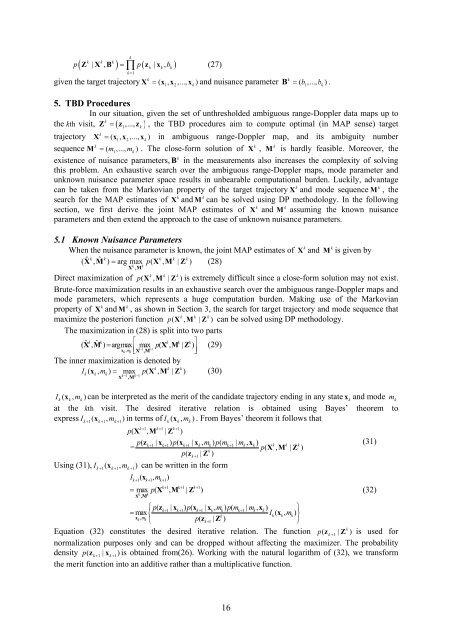Workshop proceeding - final.pdf - Faculty of Information and ...
Workshop proceeding - final.pdf - Faculty of Information and ...
Workshop proceeding - final.pdf - Faculty of Information and ...
You also want an ePaper? Increase the reach of your titles
YUMPU automatically turns print PDFs into web optimized ePapers that Google loves.
k<br />
k k k<br />
( ) p(<br />
p Ζ | X , B = ∏ zk | x<br />
k,<br />
b<br />
k)<br />
(27)<br />
k = 1<br />
k<br />
k<br />
given the target trajectory X = ( x1, x2,..., xk<br />
) <strong>and</strong> nuisance parameter B = ( b1<br />
,..., b k<br />
).<br />
5. TBD Procedures<br />
In our situation, given the set <strong>of</strong> unthresholded ambiguous range-Doppler data maps up to<br />
k<br />
the k th visit, Z = ( z ,..., 1<br />
z<br />
k ) , the TBD procedures aim to compute optimal (in MAP sense) target<br />
k<br />
trajectory X = ( x1, x2,..., xk<br />
) in ambiguous range-Doppler map, <strong>and</strong> its ambiguity number<br />
k<br />
k k<br />
sequence Μ = ( m1<br />
,..., m k<br />
) . The close-form solution <strong>of</strong> X , Μ is hardly feasible. Moreover, the<br />
k<br />
existence <strong>of</strong> nuisance parameters, B in the measurements also increases the complexity <strong>of</strong> solving<br />
this problem. An exhaustive search over the ambiguous range-Doppler maps, mode parameter <strong>and</strong><br />
unknown nuisance parameter space results in unbearable computational burden. Luckily, advantage<br />
k<br />
k<br />
can be taken from the Markovian property <strong>of</strong> the target trajectory X <strong>and</strong> mode sequence Μ , the<br />
k<br />
k<br />
search for the MAP estimates <strong>of</strong> X <strong>and</strong> Μ can be solved using DP methodology. In the following<br />
k<br />
k<br />
section, we first derive the joint MAP estimates <strong>of</strong> X <strong>and</strong> Μ assuming the known nuisance<br />
parameters <strong>and</strong> then extend the approach to the case <strong>of</strong> unknown nuisance parameters.<br />
5.1 Known Nuisance Parameters<br />
k<br />
k<br />
When the nuisance parameter is known, the joint MAP estimates <strong>of</strong> X <strong>and</strong> Μ is given by<br />
ˆ k<br />
( , ˆ k k k k<br />
X Μ ) = arg max p( X , Μ | Z ) (28)<br />
k X , Μ<br />
k<br />
k k k<br />
Direct maximization <strong>of</strong> p( X , Μ | Z ) is extremely difficult since a close-form solution may not exist.<br />
Brute-force maximization results in an exhaustive search over the ambiguous range-Doppler maps <strong>and</strong><br />
mode parameters, which represents a huge computation burden. Making use <strong>of</strong> the Markovian<br />
k<br />
k<br />
property <strong>of</strong> X <strong>and</strong> Μ , as shown in Section 3, the search for target trajectory <strong>and</strong> mode sequence that<br />
k k k<br />
maximize the posteriori function p( X , Μ | Z ) can be solved using DP methodology.<br />
The maximization in (28) is split into two parts<br />
ˆ k ˆ k k k k<br />
( X , Μ ) = argmax<br />
⎡<br />
max p( , | )<br />
⎤<br />
, k 1 k 1<br />
k m ⎢<br />
X M Z<br />
x − −<br />
k⎣X , M<br />
⎥<br />
(29)<br />
⎦<br />
The inner maximization is denoted by<br />
( , ) max ( k , k | k<br />
I x m = p X M Z ) (30)<br />
k k k<br />
,<br />
k−1 k−1<br />
X M<br />
Ik( xk, mk)<br />
can be interpreted as the merit <strong>of</strong> the c<strong>and</strong>idate trajectory ending in any state xk<br />
<strong>and</strong> mode mk<br />
at the kth visit. The desired iterative relation is obtained using Bayes’ theorem to<br />
express Ik+ 1( x<br />
k+ 1,<br />
mk+<br />
1) in terms <strong>of</strong> Ik( x<br />
k, mk)<br />
. From Bayes’ theorem it follows that<br />
k+ 1 k+ 1 k+<br />
1<br />
p( X , Μ | Z )<br />
p( zk+ 1| xk+ 1) p( xk+ 1| xk, mk) p( mk+<br />
1| mk, xk)<br />
(31)<br />
k k k<br />
= p( X , Μ | Z )<br />
k<br />
p( zk+<br />
1<br />
| Z )<br />
Using (31), Ik+ 1( x<br />
k+ 1,<br />
mk+<br />
1)<br />
can be written in the form<br />
Ik+ 1( xk+ 1, mk+<br />
1)<br />
k+ 1 k+ 1 k+<br />
1<br />
= max p( X , Μ | Z )<br />
(32)<br />
X<br />
k<br />
, Mk<br />
⎧p( zk+ 1| xk+ 1) p( xk+ 1| xk, mk) p( mk+<br />
1| mk, xk)<br />
⎫<br />
= max ⎨ Ik( xk, mk)<br />
k,<br />
m<br />
k<br />
⎬<br />
x k⎩<br />
p( zk+<br />
1<br />
| Z )<br />
⎭<br />
k<br />
Equation (32) constitutes the desired iterative relation. The function p ( zk<br />
+ 1<br />
| Z ) is used for<br />
normalization purposes only <strong>and</strong> can be dropped without affecting the maximizer. The probability<br />
density p ( z )<br />
k+ 1<br />
| x<br />
k+<br />
1<br />
is obtained from(26). Working with the natural logarithm <strong>of</strong> (32), we transform<br />
the merit function into an additive rather than a multiplicative function.<br />
16
















